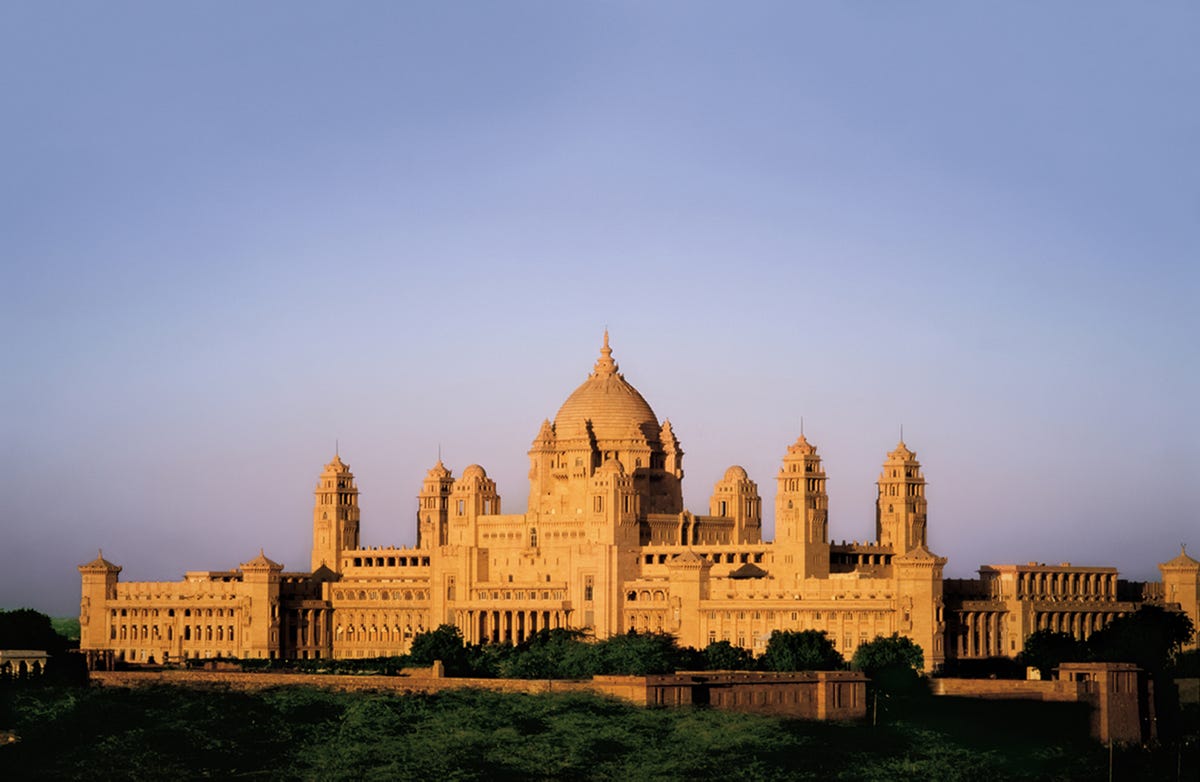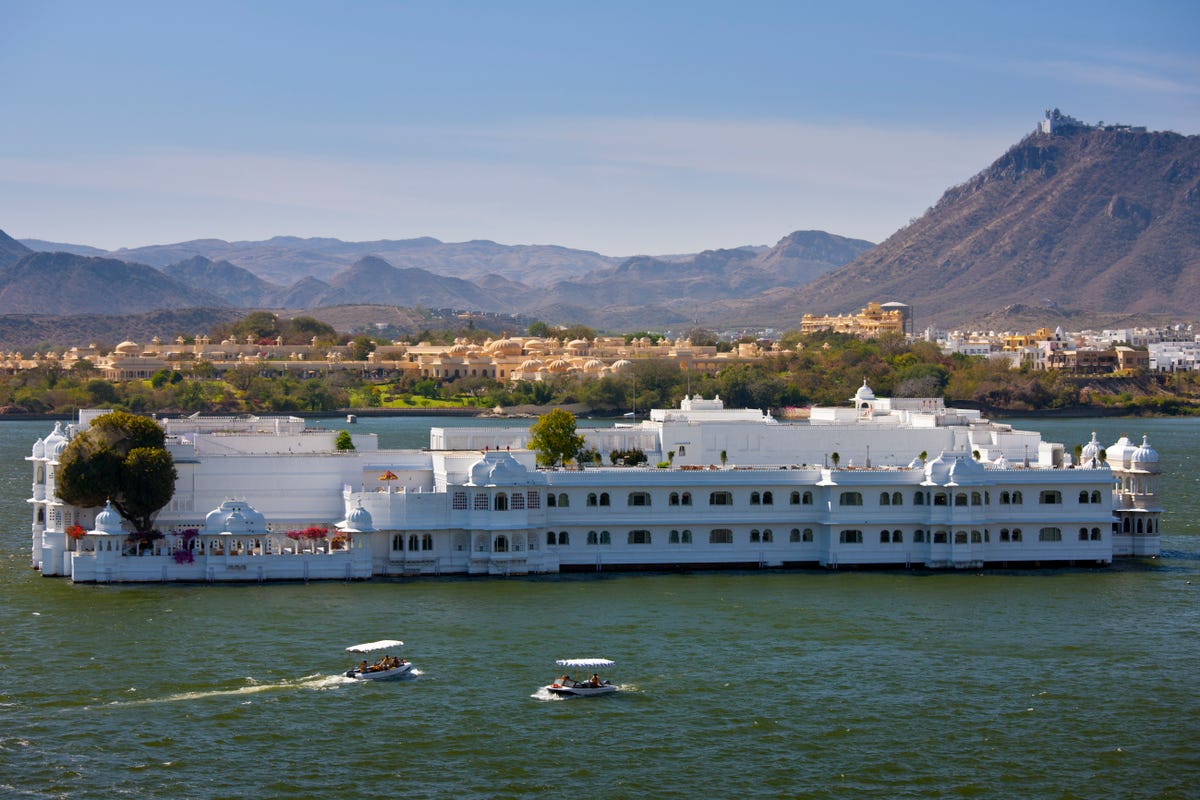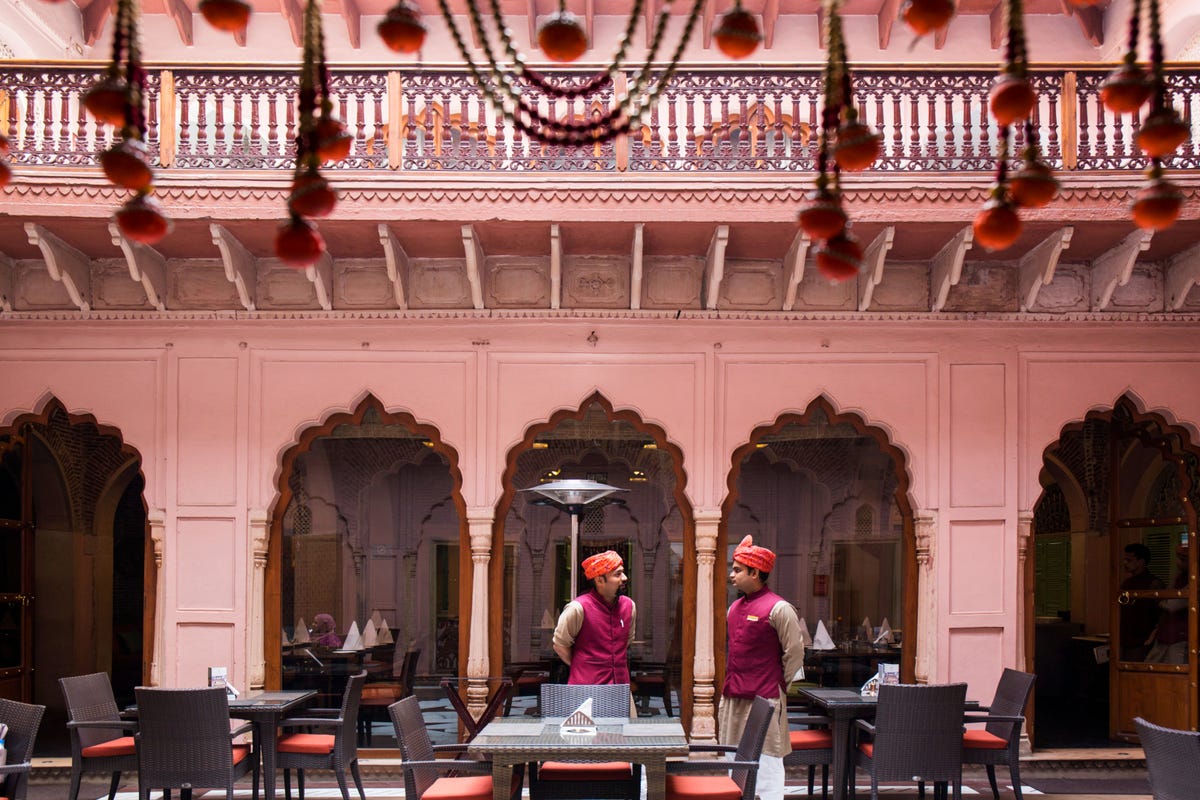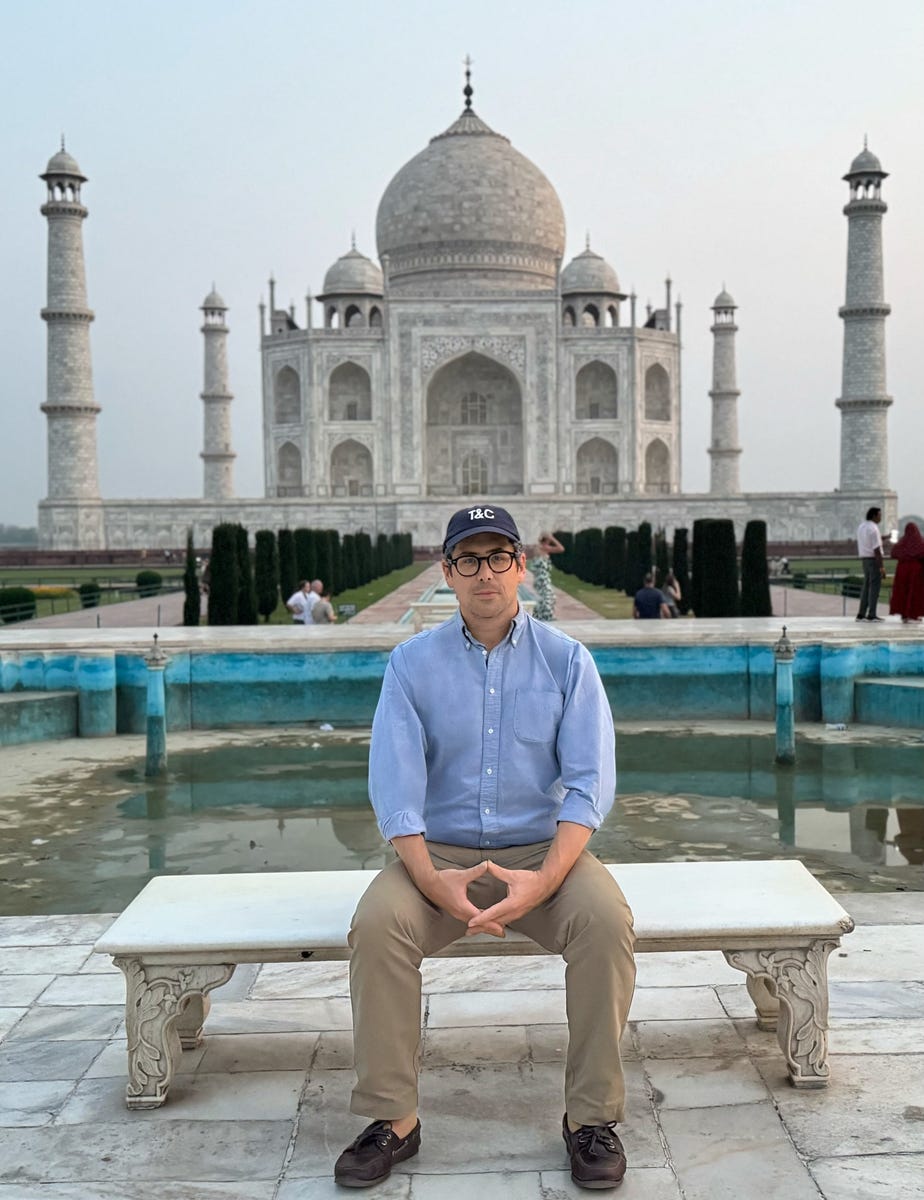I thought for sure the maharaja would give me the slip. A meeting had been scheduled with Gaj Singh II, known to almost everyone as Bapji, the day before, but our tête-à-tête had been delayed. A call to my room at Jodhpur’s Umaid Bhawan Palace , which was formerly His Highness’s family home and is now a 71-room hotel with a wing where the royal family still resides, let me know he’d be available that afternoon—probably. At the appointed time I beelined to the property’s cavernous lobby to wait, while a traditional musical trio played the soundtrack to my anticipation. Eventually a hotel employee approached and beckoned me to follow her; we made our way through a series of grand hallways that looked nearly identical until we reached a door where a group of guards gave me the once-over before breaking into smiles and bringing me to a sitting room chockablock with family photos, silver trinkets, and porcelain figurines.
When the 77-year-old diplomat, politician, and philanthropist, who has held his title since 1952, arrived, I wondered what I’d been so worried about. Instead of imposing or imperious, Bapji was chatty and wryly funny. He sat barefoot in an armchair to my left and spoke about his affection for the region, what studying at Eton and Oxford made him appreciate about Jodhpur, and his concern over the loss of traditions. The 26th amendment to India’s constitution, which was enacted in 1971 and did away with the special privileges of the rulers of princely states, still does not thrill him. A servant brought him a silver cup full of toothpicks, and after using one he shared his excitement for an upcoming safari in Kenya. I asked if the figurines that dotted the room were something he collected. No, he said with a chuckle, the staff just put them here. After about half an hour, I’d taken enough of his time. He presented me with a book about his family’s history and pointed me toward the door. A small brown and white dog sat on a chair and barked as I made my way back to the part of the palace where hotel guests belong.
I hadn’t been granted an audience with the 39th ruler of his dynasty, a man who succeeded his father at the age of four, because of my charm or good company. I was there because of Velocity Black .

Founded in 2014 and acquired in 2023 by Capital One, Velocity Black is a digital concierge service that offers members 24/7 access to human experts in travel, dining, luxury goods, and entertainment. The idea is that by using the Velocity Black app—for which one must apply and be approved to join—members can request anything from reservations at impossible-to-get-into restaurants to help locating that hard-to-find Royal Oak or a helicopter pickup from a mountaintop (true story!) and get a response in seconds. The app also offers a host of perks for members, including VIP access to concerts, art fairs, and F1 races, private visits to some of the world’s most desirable tourist destinations, the ability to snag the sort of watches and handbags that even top-tier collectors only dream about, and extras at the hotels, spas, restaurants, and events that lure in the one percent around the globe.
Everyone who joins fills out an extensive questionnaire to specify everything from dietary restrictions to hotel preferences, and the more members use the app, the better it learns their likes and dislikes. Over time that helps sharpen digital recommendations and informs those experts in their support of your every whim. So when the service offered a membership and tasked me with using it to plan a hosted dream vacation, it was impossible to resist.
It’s not as easy as it sounds to figure out where in the world you’d go if an army of specialists were on hand to arrange the trip. My persistent itch to explore the American Southwest felt too domestic, an adventure in Antarctica potentially grueling, a behind-the-scenes tour of the great museums of Europe too similar to the educational vacations my parents love. Sara Haney, Velocity Black’s vice president of tailor-made trips, helped me zero in on something that seemed just right: India and its palaces, artisans, and wildlife.

Once the decision was made, things moved quickly. Through the app (and a few short phone calls), I shared with the team what my perfect trip would include. Grand hotels were a must, but I wouldn’t want to skip street food. Historic sites and local culture appealed, but not so much that time for shopping was tight. Bustling cities are my favorite places, but nature can be nice too. And, however inconvenient, I’d love to visit the Taj Mahal, which I regretted skipping on my last trip to India. There was a minimal amount of back-and-forth—and some truly impressive expediting of my visa—and before I knew it an itinerary arrived, packed with J. Peterman–esque descriptions of after-hours visits to temples and forts, private dinners on rooftops in ancient cities, leopard safaris, and, yes, a meeting with the maharaja.
On a call after I returned, Haney said, “It can start with a simple request, just ‘I want to go to India’ and not much else. We take it from there and use everything that we have based on your history with us to curate everything from start to finish.” What Velocity Black does exceptionally well is figure out what members might like beyond the initial request. “We allow a lot of space for surprise, too,” Haney adds. “There are areas that we know members might like or that will delight them before they even know that they like it.”
I didn’t imagine Delhi would be surprising. I had been to the city before and found it exhausting and overwhelming. But I’d never been in the hands of Rohit Gehlot, the veteran tour guide paired with me for the trip.
Rohit met me at Indira Gandhi International Airport and handled all the logistics of speeding us out of the terminal. Soon we were in a car (fully stocked with my favorite drinks and snacks) and making our way to the historic Imperial Hotel . Upon arrival I was informed my room had been upgraded—a Velocity Black trademark, I would find out—and filled with treats and gifts. I could have gladly spent the day eating samosas by the pool, but instead Rohit whisked me off to the Chandni Chowk market. He knew every corner of the teeming bazaar, pointing me toward cups of steaming chai, stopping to pick up sweets, and hiring a tuktuk driver to buzz through the tight alleys packed with spices, jewelry, and miles of festive fabric. Before exhaustion set in, he led me to Haveli Dharampura , a 19th-century mansion and UNESCO heritage site, for afternoon tea, a chat with the house’s chatelaine, and a trip to the roof to fly a kite, something the local children on neighboring roofs were also doing. Back at the hotel, before dinner at its famous Spice Route restaurant (which is decorated in part with works from a 400-year-old temple in Kerala), a local Velocity Black staffer stopped by to say hello. In a matter of hours, Delhi had stopped seeming quite so big.
It was nearly 100 degrees the next morning when we landed in Jodhpur, but the waiting car was air-conditioned to American perfection, and chilly water was offered on an actual silver platter. Arriving at the Umaid Bhawan Palace , I was greeted with a garland of marigolds and a drum-castanet-harmonium trio playing beneath the lobby’s impressive domed ceiling. The outside of the building was almost pink against the blue sky, and the interior had the feeling of a museum—perhaps in part because there actually is one in there somewhere. Rohit and I decided to stroll through the old city, known for the blue color the local Brahmins painted their homes. A religious holiday made for a hushed afternoon as we walked up to Mehrangarh , a fort dating back to the 15th century, just in time for the golden glow of the late afternoon and a private tour with a curator through the antiquities and grand rooms to learn the history of the place. The only other guest we saw milling about was, we were told, a Marwari princess. The night was capped off with a private performance of Bhopa Bhopi, a traditional Rajasthani dance, on the roof of a nearby restaurant, and a surprise tuktuk ride to a local architectural attraction that I had mentioned in passing sounded interesting. Beware, I reminded myself, what you mention to Rohit, because you just might get it.
Before I delve into the rest of the trip, I need to admit that I had a problem. I was meant to put the Velocity Black app to the test, firing off requests to the team for ways I wanted my trip to be tweaked. But for once in my life I had nothing to complain about. I sent one note about wanting to change spa treatments later in the trip (the spa was closed for the night, I was politely informed, but they’d handle it in the morning) and another hoping for an afternoon tea experience when I got to Udaipur (not a problem). About the only thing the app’s team couldn’t help with was some medication I’d left at home; upon hearing about this Rohit offered to stop at a pharmacy and pick some up immediately. I made a mental note to be a bit more difficult.
The next day’s start was slightly delayed by the pride of peacocks strolling the palace lawn, but before long we were off to Jawai. Along the way, we shopped. Rohit knew I have a weakness for fabrics and arranged a visit to a private room at Maharani Textiles , where the owner shared fantastical tales about celebrity clients and Italian fashion collabs—and I believed him just enough to walk away with an armful of blankets and scarves that required a new suitcase. “You’re killing me,” I told him when he rolled out some gorgeous vintage carpets. “I wouldn’t,” he shot back. “I’m Jain.”
After another stop (and purchase) at the home of a local rugmaker, we arrived at the Suján Jawai safari camp, which was staffed in part by members of the nomadic Rabari tribe, known for their spiritual bond with the leopards of the region. I was thrilled to see two of the big cats on our first game drive, but I was even more impressed by how much I felt I needed the quiet of the isolated camp after a few nonstop days in bustling cities. “It was super-intentional to put that in there,” Haney told me later. “Not only did it make logistical sense, we knew how fast-paced Delhi and Jodhpur were going to be. There were a lot of experiences on those first days, and we needed to get you back into nature. We know how intense India is, and we build those in to ensure that you’re not maxed out on day two.” This was the India that I wanted but that I hadn’t known to ask for.

Two days in Jawai certainly took care of that. From there we drove to Udaipur, where our first stop was a tailor shop. A friend had recently told me having suits made in Udaipur was necessary, and when I flagged the request for Velocity Black, they said not only did they know a great tailor, he happened to be my guide’s brother. After a quick fitting at his shop, Sandouk House of Fashion, we checked into the iconic Taj Lake Palace (almost everyone will tell you Octopussy was filmed here). My room, the Sarva Ritu, was formerly a queen’s chambers.
We took advantage of the afternoon tea and the in-house astrologer, and we went for an evening stroll along the waterfront Gangaur Ghat, where Rajesh Soni , a local artist whose ancestors were photographers for the region’s royals, met us for an impromptu portrait session. Dinner that night would be at the Mountbatten Supper Club, a not-quite-open-yet project from hospitality impresario (and the cousin of a previous maharaja) Reggie Singh, who opened the private club and fussed over the jazzy playlist himself simply because someone at Velocity Black had asked.
After a second day of shopping and eating in Udaipur, I checked in for my final night at a villa on the grounds of the Leela Palace , just across the lake. The arrival was another riot of marigold garlands, and when I stepped into my room it was festooned with framed photos pulled from my Instagram, and there was an employee waiting to wash my feet. Really. This stay was all about rest and relaxation—a spa treatment, a sunset lake cruise, a dinner on the terrace overlooking the city. I needed my rest, after all, as the next day would be my last. (The perfect new suits arrived at my hotel the morning I left.)

First thing in the morning we flew back to Delhi. Then we drove, stopped for samosas at the side of the road, and drove some more. By the time we reached Agra I was spent, but checking into the Oberoi Amarvilas and seeing the way my room looked directly out at the Taj Mahal was a reminder that I could be tired at home. The next morning we got in line for the Taj Mahal before sunrise—but thanks to Rohit’s knowhow (and some well-placed tips), we outmaneuvered the crowds to get quiet, solo moments in some of the landmark’s most beautiful corners. Thousands of people would stream into the grounds that day, but it felt almost as if we had the place to ourselves. “There’s nothing they don’t think of,” he said of Velocity Black, for which he has hosted many tours.
More proof was on offer on my final day. We made it to Delhi with hours to kill before my flight. Knowing my interest in both air-conditioned, quiet places and modern art, Rohit arranged a visit to Delhi’s National Gallery of Modern Art , and to keep me from having to cool my heels in the airport lounge, I was booked into a room at the city’s Leela Palace for an evening of room service and one last shower before the 16-hour flight home. It was an unnecessary indulgence, but that’s exactly what Velocity Black does.
It would have been enough to stay at incredible hotels, to track leopards through the mountains, to sit and watch the sunrise over one of the seven wonders of the world. What made the trip really live up to its promise, though, were the trips to out-of-the-way temples, the meals at the homes of local nobles, and the teas with artists working in ancient traditions. The real perk of membership isn’t the travel planning service, it’s the doors that are opened on your behalf, and the feeling that when you’re walking into restaurants or galleries or a maharaja’s home, you’re not just a visitor, you’re a guest.
On our post-trip call, I asked Haney what my behavior on the trip had taught her about me as a member. She flattered me a bit, telling me what a good time Rohit had and how easy I’d been to work with. I pressed more. “We learned what you like and what you don’t like,” she said diplomatically. “And we learned about your pace.”
My pace? She rephrased it the way a member might want to hear. “I heard you did a good job of giving Rohit a heads-up in the car every time you were about to fall asleep. We know you like your siesta.”
They had figured me out after all.
This story appears in the Summer 2025 issue of Town & Country. SUBSCRIBE NOW

